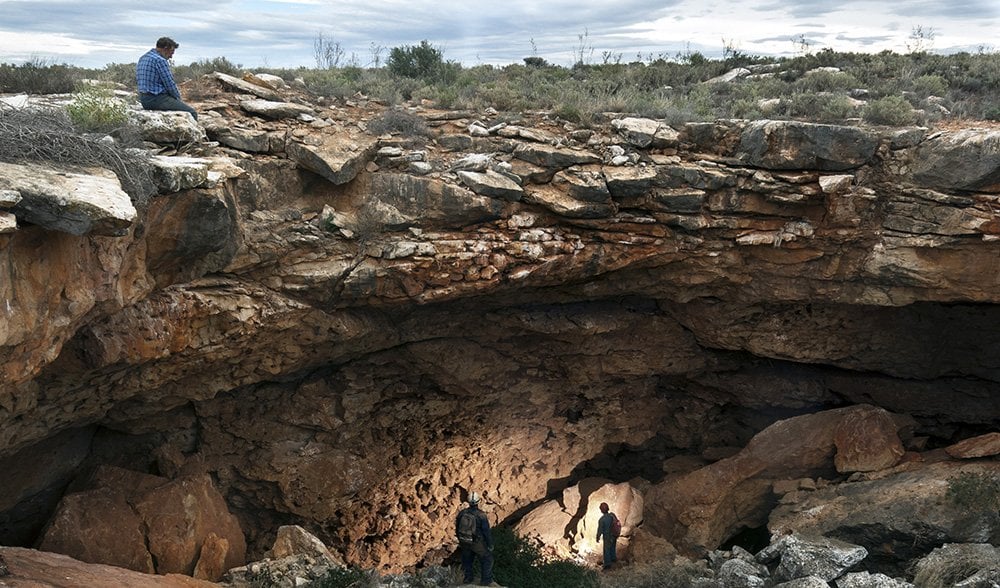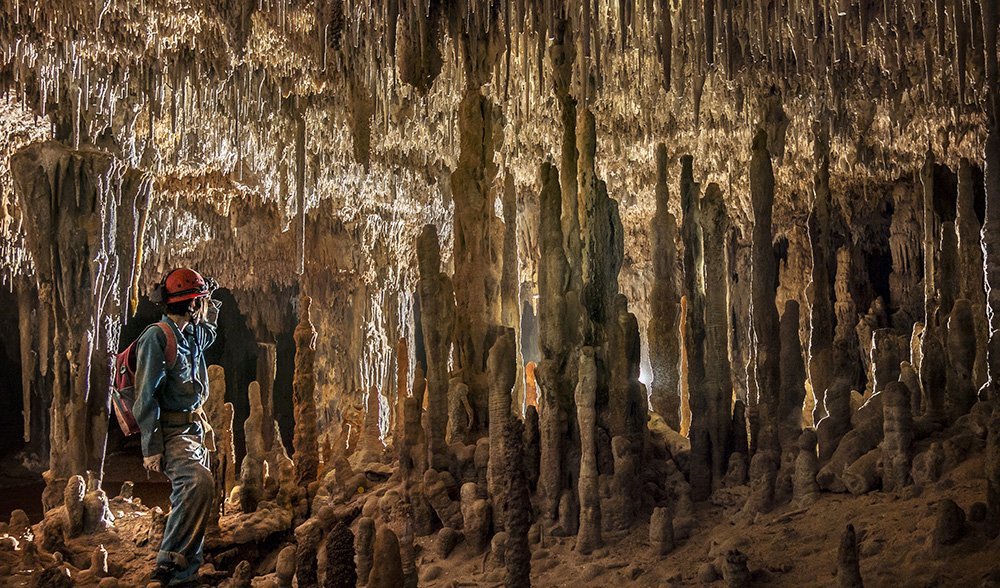Hidden Nullarbor

Almost exactly 100km west of the Western Australia–South Australia border Graham Pilkington clambers down a fissure that’s not much wider than his body into one of the first of Old Homestead Cave’s large passages.
Light from his head-torch pierces the blackness only faintly as his hands grip a ladder that has been made slippery by the cave’s 90 per cent humidity, before his boots thump to the cave floor, raising a dull echo.
This low, wide entry passage sits below the Nullarbor Plain, the world’s largest limestone karst landscape, which is tens of millions of years old. The Nullarbor – a dry, flat, 200,000sq.km savannah – stretches 1100km along the southern coast of Australia from Balladonia east of Norseman, WA, to north of Yalata in SA.
Above ground it is famously featureless. Edward John Eyre, the first European to cross the Nullarbor in 1840–1841, described it as the “sort of place one gets into in bad dreams”. But beneath the surface is a complex world of tunnels within a vast slab of limestone.
The Old Homestead Cave – one of Australia’s longest cave systems yet discovered – comprises about 34km of known tunnels and chambers across four levels. These are filled with stalactites and stalagmites, smooth flowstone, and the occasional curling tendrils of gypsum crystals that grow out from the walls.

Some of the other equally impressive Nullarbor cave systems are protected within the 28,730sq.km Nullarbor National Park and Regional Reserve. Another 9000sq.km falls within the Nullarbor Wilderness Protection Area.
Karst topographies such as this are created when water seeps through large expanses of soluble rocks, such as limestone or dolomite, riddling them with sinkholes and caves, like holes in Swiss cheese. Dripping with stalactites, the chamber Graham is exploring is beautiful but also packed with information.
“We think of the shape of the cave itself as nice to look at – every shape also shows you the history of the cave,” he says. A life member of the Cave Exploration Group of SA, Graham is the expert on the Old Homestead Cave. It’s his life passion to slowly map this remote cavern, and he’s visited almost every year for more than three decades.
Exploring the caves that riddle Nullarbor has also been a lifelong obsession for a very select group of cavers and cave-divers. Among them are Andrew Wight, the AG Society’s 1989 Spirit of Adventure awardee and a documentary maker who helped designed the 3D technology behind Avatar, who some may remember was killed in a helicopter crash in 2012; and Ron Allum, creator of the Deepsea Challenger submarine that in 2012 took Hollywood director James Cameron to the bottom of the Mariana Trench. Indeed, James helped produce Sanctum in 2011, a suspense-thriller based on the true story of 15 cavers, including Andrew, who became trapped in a Nullarbor cave in 1988 after the entrance collapsed.

All this limestone began to form more than 50 million years ago when the continent broke away from Antarctica and the sea flooded into the subsequent gap. The calcium carbonate shells of tiny sea creatures accumulated on the ocean floor, eventually forming into a chalky layer of limestone. More recently, the sea retreated and the southern part of Australia tilted, lifting up the 100m-high sea cliffs that line the southern coast of the Nullarbor today.
Ian Lewis, a karst geomorphologist based in Adelaide, describes the Nullarbor as one of very few places in the world where the limestone retains its original shape – a vast, flat disk, hardly touched by the grinding, breaking and buckling pressures of tectonic plates colliding.
“The southern end of Australia is geologically peaceful,” he says. “That ancient sea floor has been relatively untouched for millions of years.” If the limestone had been in the north of the continent, it would have been scrunched up into mountains in New Guinea, or pushed under the ocean floor he adds.
There is a great variety of cave types under the Nullarbor, but the plain’s most interesting features are long, deep systems (such the Old Homestead Cave), which are found only here, in the US state of Florida, and on Mexico’s Yucatan Peninsula, all of which all have similar karst limestone layers.
In fact, geologists are still trying to understand precisely how the Old Homestead formed. The main theory is that groundwater ate away at the Nullarbor’s bedrock, making it porous.

Then, during a wetter era, rainfall seeped into the porous rock and cracks, slowly dissolving the limestone and eventually forming an extensive network of passageways. Over time, pockets near the surface collapsed, creating dramatic entrances.
“Most of the theories about caves have been developed in Europe and North America, where running water has been the main process creating caves,” Ian says. “In those places, limestone is generally compressed, hard, raised up, and hilly – with rivers and streams all carving away at it. Instead, our caves have been dissolving quietly beneath the ground.”
Satellite imagery appears to support the hypothesis that ancient groundwater had a role in creating the unusual cave systems. Although the Nullarbor is largely stable, fractures in the rock suggest there may have been some flexing of the enormous layer of limestone bedrock.
It makes sense, Ian says. “It’s the world’s biggest slab of limestone, and it’s huge and thin. If that’s the case, it is most likely that the longer caves are forming along long pressure cracks.”
This process might also explain Old Homestead’s length. “Old Homestead is a bit of strange one. It’s way out in the middle on its own, but it’s 34km long,” says Ian, who also argues that its position at the centre of the Nullarbor may be key – as the centre is weakest if the whole slab is flexed. Imagine pushing at the edges of a soap bar – the middle is likely to crack, letting in more water to expand and lengthen the cracks.
For Graham, whose team returned in 2015 to map unknown sections of the cave’s second level, it’s a pleasantly lengthy puzzle that still holds his attention. “There’s so much of it and we always find something different,” he says. “One day you walk this way and you’re looking in one direction, the next day you’re looking in another, and you find another passage and something completely new.”
This article was originally published in the Jan-Feb 2016 edition of Australian Geographic (AG130).






